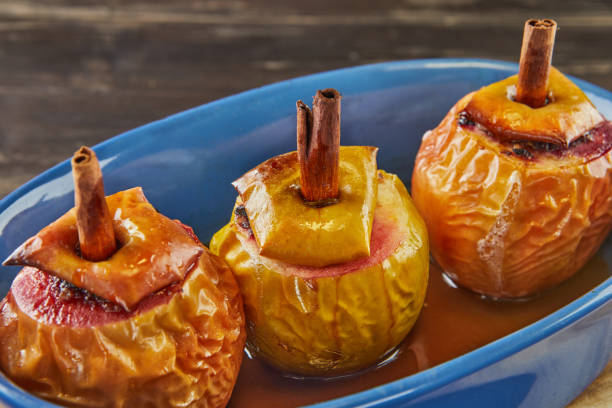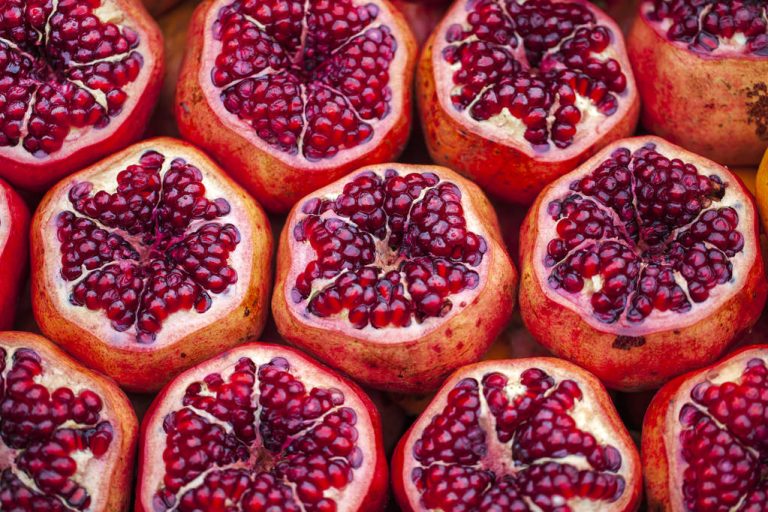From a culinary point of view, the pre-Christmas period offers many delicious delicacies: Whether tree cake, cookies or gingerbread – you are spoiled for choice when it comes to Advent coffee. But now we would like to offer you a tasty and, above all, healthy alternative: how about a hot baked apple in vanilla sauce? The fruit can be prepared in the oven or quickly in the microwave. Make baked apples yourself – it’s easier than you think!
Not a baked apple fan yet? That should change soon. Baked apples are a wonderful alternative to cakes and cookies, especially in winter. What’s more, this wintery delicacy is easy to prepare yourself. But read for yourself…

To prepare baked apples, you should first use firm and tart apple varieties. The red Boskoop, Gravensteiner, or Cox Orange are excellent.
Years ago, you just popped the apple into the hot oven and waited for it to pop before sprinkling the cinnamon and sugar on it. Today, on the other hand, the core of the apple is removed and the resulting cavity is used to add delicious ingredients. There are actually no limits to the imagination. What you like is allowed in terms of ingredients. In addition to almonds, raisins, muesli, oatmeal, some honey, and hazelnuts, you can also add nougat, marzipan, jam, or winter spices to the baked apple. A few knobs of butter ensure that the apple does not become too dry. And the savory version of the treatment also causes a stir!
By the way: If you don’t have much time and don’t want to do without your baked apple, you can also prepare the wintry dish in the microwave. Depending on the size, the apple can be heated in a bowl for three to five minutes at around 600 watts and then left to cool for two minutes. We wish you Bon appetite!
Make baked apple yourself
Ingredients for 2 servings:
- 1 tbsp dried cherries
- 1 tbsp dried cranberries
- 1 tbsp sultanas
- 6 tbsp apple juice
- 2 tart apples (200 g each)
- 1 tbsp chopped almonds
- ½ vanilla bean
- 1 tbsp cane sugar
- 150 g yogurt (0.3% fat)
- 2 tbsp eggnog (optional)
You will need these kitchen appliances:
- 1 casserole dish
- 1 bowl
- 1 small bowl
- 1 work board
- 1 small knife
- 1 tablespoon
- 1 teaspoon
- 1 core cutter
Preparation steps:
- Place the dried cherries, cranberries, and sultanas in a small bowl with 2 tablespoons apple juice and soak.
- Wash the apples and remove the core with an apple core.
- Add the chopped almonds to the cherries, cranberries, and sultanas and mix everything together.
- Using a teaspoon, spoon the mixture into the apples and place in a casserole dish.
- Pour over the remaining apple juice. Bake in a preheated oven at 200 °C (fan oven: 180 °C, gas: mark 3) for 30-35 minutes.
- Meanwhile, split the vanilla pod lengthways, scrape out the pulp with a sharp knife and mix with the sugar.
- Mix the vanilla sugar with the yoghurt and, if you like, eggnog until smooth. Place on plates, place 1 baked apple on each and serve.
Baked apple with ginger

Ginger is a wonderful ingredient that relieves colds and adds a wonderfully savory touch to baked apples. If you like ginger, you should definitely try this baked apple variant! Ingredients for 4 people: 4 yellow apples 2 tbsp. sugar ½ tsp. cinnamon 1 pinch ginger powder 1 piece of fresh ginger 4 tsp. icing sugar 400 ml apple juice (or white wine) 1 cinnamon stick ½ vanilla bean 2 tbsp. Remove the core with a melon baller.
Mix the sugar with the cinnamon and ginger powder, sprinkle into the opening, and put the lid back on. Peel the ginger, and cut it into fine strips. Caramelize the icing sugar in an ovenproof pan, and deglaze with the apple juice. Add the cinnamon stick, ginger, and the sliced vanilla bean, and simmer briefly. Put the apples in and bake in the oven at 180 °C for about 25 minutes. Take the apples out of the sauce and keep them warm. Stir cold butter into the caramel sauce. Spread the sauce on dessert plates as a mirror, place the apples on top and sprinkle with icing sugar.





